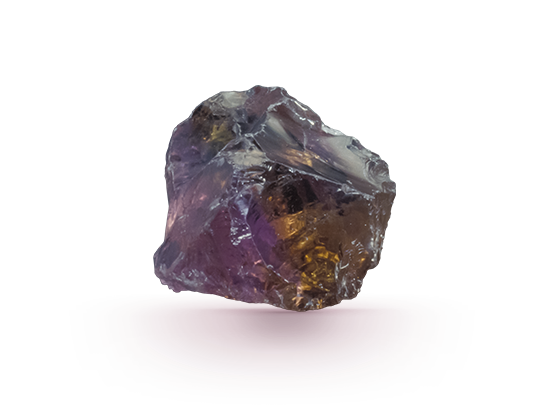OVERVIEW
Whether projecting from pegmatite walls or encrusting cavities in volcanic rock, quartz abounds worldwide. People have used quartz in jewelry for thousands of years. When quartz displays the colors of amethyst and citrine in a single gem, the material is called ametrine or amethyst-citrine. Ametrine’s only commercial source is the Anahi mine in Bolivia.
Transparent, bicolored quartz with the colors of both amethyst and citrine in the same gem is called ametrine or amethyst-citrine. The contrasting colors give it an intriguing appearance.
Fine ametrine shows medium dark to moderately strong orange, and vivid to strong purple or violetish purple. Larger gems, usually those over 5 carats, tend to show the most intensely saturated hues. Dealers look for an attractive half-and-half distribution of each color, with a sharp boundary between the two colors at the center of the fashioned gemstone.
Ametrine is often cut as a rectangular step cut because that style nicely displays the bicolor effect. Cutters try to emphasize both colors equally.
- Mineral: Quartz
- Chemical composition: SiO2
- Color: Bicolor orange/yellow and purple
- Refractive index: 1.544 to 1.553
- Specific gravity: 2.66 (+0.03/-0.02)
- Mohs hardness: 7
BIRTHSTONE
HISTORY
The world’s only commercial source of ametrine is the Anahi mine in southeastern Bolivia. Legend has it that a Spanish conquistador discovered the mine’s location in the 1600s and introduced the gem to Europeans when he presented several specimens to his queen. The mine had been given to him as a dowry when he married a native princess named Anahi. After that, the mine was lost for more than three centuries. Rediscovered in the 1960s, the mine’s ametrine began appearing on the market again during the 1970s. Today the mine, named Anahi for the legendary princess, also produces natural amethyst and citrine.
The mine area is remote. Travel to and from the mine is limited to a flight in a small airplane or by a combination of roads and boats. Some supplies and personnel travel to and from the mine by air. Supplies and mine production move by boat. It’s not hard to imagine why the mine’s location was lost for centuries.
Source of Content : www.gia.edu


